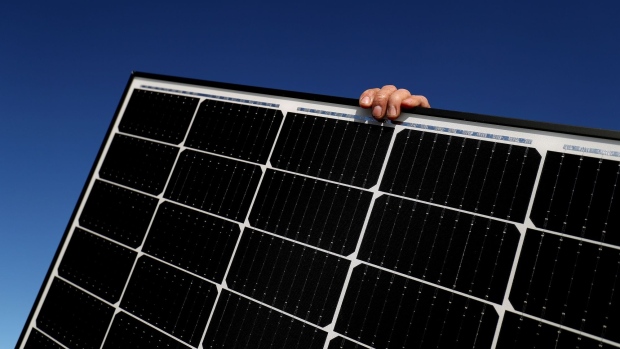Feb 14, 2023
Biden Earmarks Billions for Rooftop Solar Under Climate Law
, Bloomberg News

(Bloomberg) -- The Biden administration laid out plans to steer $7 billion toward residential and community solar projects in disadvantaged communities, while signaling it intended to widely distribute roughly $20 billion from last year’s climate law to catalyze clean energy investments nationwide.
With formal notices published Tuesday, the Environmental Protection Agency said it envisioned doling that nearly $20 billion to as many as 15 community development organizations, credit unions, housing agencies and other not-for-profit institutions, largely rebuffing entreaties to dedicate the money to capitalize a single, nationwide green bank.
The initial spending blueprint marks a major milestone for the $27 billion Greenhouse Gas Reduction Fund, a centerpiece of last year’s tax-and-climate law meant to drive the deployment of solar panels, heat pumps and electric vehicles around the nation. The Inflation Reduction Act left major questions — including precisely who should get the funding — to the EPA, which is tasked with ensuring at least 40% of the benefits flow to impoverished communities often neglected by commercial lenders.
“Low-income communities and disadvantaged communities who pay the largest percent of their income toward energy bills have been left out of the investment game,” EPA Administrator Michael Regan told reporters in a briefing Tuesday. “Many of these communities have not seen the infusion of private capital to help them realize opportunities, whether it be energy efficiency or rooftop solar or any of the clean technologies.”
This is an effort to bring that population “along for the ride,” Regan said.
The EPA is setting the stage for a formal funding competition this summer. It is deferring major questions about how to divvy up the $20 billion it is allotting for a new “general and low-income assistance competition,” under which it will dole grants to between two and 15 entities. The recipients will be charged with leveraging the money to lure private capital toward projects that curb pollution and lower energy costs.
That’s a setback for the Coalition for Green Capital, a nonprofit that supports regional green banks and has spent months arguing it should be the sole recipient of the $20 billion, making it a nationwide clearinghouse for the money. Other potential recipients, including credit unions and community development financial institutions, have countered they are best positioned to drive investments in long-neglected communities while maximizing the program’s emission-cutting dividends.
Read More: Green Banks Get $27 Billion Windfall to Lend Where Others Don’t
Regan and EPA’s acting director of the program, Jahi Wise, stressed they weren’t ruling anything out, and said they were confident the law gives the agency flexibility to design a program with multiple grant recipients.
“At this juncture, there’s just no reason for us to take any options off the table and box ourselves in,” Regan said. He pledged a “deliberate and thoughtful process to really harness the ability to maximize leverage and scale,” with the goal of maximizing the opportunity for the working class and disadvantaged communities.
Wise stressed that while the EPA is still working to “figure out how you design the optimal system for these resources,” an “entity with national scope will be a part of this this ecosystem that’s being built here. We just need to do a lot of work between now and early summer to design an optimal competition to achieve those goals.”
The agency has until Sept. 30, 2024 to award grants from the $27 billion fund to deploy zero-emission technologies and carry out other carbon-cutting activities. This will be among the first big spending outflows under the IRA, which included unprecedented credits and incentives for clean energy projects and technologies.
In addition to the competition for the $20 billion, the agency said it envisions awarding up to 60 grants under a separate $7 billion “zero-emissions technology fund competition” dedicated to states, tribes, cities and eligible non-profit entities to deploy residential rooftop solar and community solar along with associated power storage systems and upgrades in low-income and disadvantaged communities.
Small green banks across the US have already helped propel such community-based solar projects, which use localized installations of panels to generate power for the grid and generally curb energy bills in the process. The projects already are primed to benefit from an expanded 30% tax credit for residential solar systems under the Inflation Reduction Act.
“Distributed solar is one of the most affordable, cleanest and resilient forms of energy available to American families,” Regan said. Investing in solar will “be critical in achieving the administration’s greenhouse gas reduction targets while also lowering energy costs for communities across the country.”
©2023 Bloomberg L.P.






